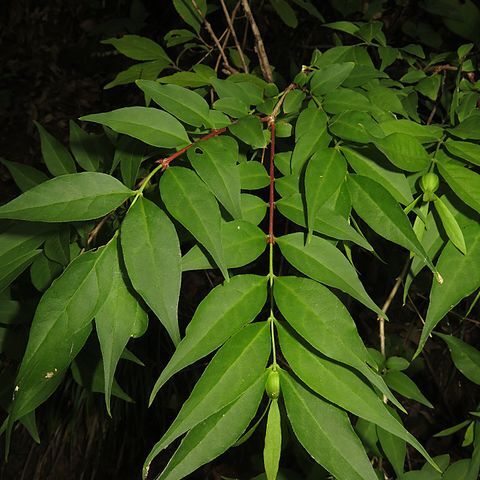Shrubs deciduous, root hemiparasites. Winter buds acute, with 2-5 pairs of scales. Leaves opposite, shortly petiolate to almost sessile, often lanceolate to ovate, membranous, pinnately veined, margin entire or very minutely serrulate, tips of first-formed leaves prominently scarious and scale-like. Inflorescences axillary and terminal; male ones cymose or umbellate; bracts absent. Flowers unisexual (plants dioecious). Male flowers small, perianth 4(or 5)-lobed, campanulate. Stamens 4(or 5), short; filaments filiform, cells parallel, dehiscence longitudinal. Disk superior, adnate to perianth tube, sinuate at margin. Female flowers terminal, sometimes also axillary, solitary; bracts sepal-like, 4(or 5), subterminal on ovary, leafy, alternate to perianth lobes, enlarged after flowering, ± persistent; perianth tube adnate to ovary, lobes 4(or 5), tiny; staminodes absent. Ovary inferior, 8-ridged or smooth when young; ovules 3 or 4. Style short; stigmas 2-4. Fruit a drupe, with deciduous perianth lobes, exocarp ± thinly fleshy, endocarp bony; bracts 4(or 5), prominent, near fruit apex, accrescent, aristate, persistent or deciduous.
More
Shrubs, dioecious. Stems hairy. Leaves opposite or subopposite, distichous to decussate. Inflorescences: staminate 1–3[–5] dichasia, pistillate flowers solitary, subtended by 2 pairs of decussate, deciduous bracts. Pedicels: staminate present, pistillate absent. Flowers unisexual. Staminate flowers: hypanthium absent; sepals 0; petals 4, post-staminal hairs absent; nectary squarish; stamens 4. Pistillate flowers: hypanthium completely adnate to ovary; sepals 4; petals 4; nectary squarish; ovules 3–4 per locule; stigma 4-lobed. Pseudodrupes: exocarp fleshy; pedicels not enlarging or becoming fleshy; sepals accrescent, deciduous [persistent], petals deciduous. x = 15.

